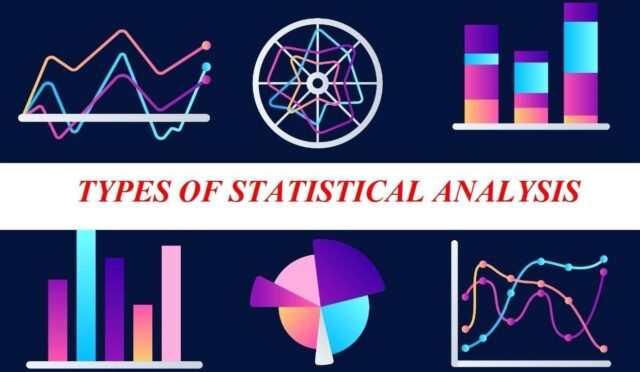Introduction
Many companies and organizations today use statistical analysis to analyze data and make decisions. Statistical analysis techniques take many forms and are used for various data, sectors, and applications. As a result, knowing how to use the various statistical analysis tools will assist you in exploring data, identifying patterns, and identifying market trends. This blog post thus defines statistical analysis and explains the different types with examples. So, let’s get started.
What Is Statistical Analysis?
The method of gathering, arranging, and analyzing the data to uncover trends and patterns following established principles is known as statistical analysis.
It is a diverse field that includes academia, industry, social sciences, genomics, and demographic research and technology. The statistical analysis serves several furthers. It can predict, model, reduce risk and detect trends.
Common Terminologies in Statistical Analysis
So, before we get into the main purpose, let’s connect with some of the common terminologies, and their definitions to come a long way.
Statistics is a discipline of science concerned with gathering, organizing, assessing, and interpreting data from samples to the overall population.
A sample is a tiny section of the population representing the entire population regarding the research feature.
Statistical tools such as SAS, SPSS, STATA, and others are now accessible to analyze statistical data ranging from simple to complicated difficulties depending on the study’s nature.
Major Types of Statistical Analysis
Below are the seven statistical analysis types:
1. Descriptive Analysis
The most basic type of statistical analysis is descriptive statistics, which uses numbers to explain the characteristics of a data collection. It simplifies the interpretation of enormous data sets by reducing them to primary and compact forms. It summarizes data from a sample or represents an entire sample in a research community and uses data visualization tools to simplify analysis and interpretation, including tables, graphs, and charts. But it is ineffective when it comes to drawing inferences. So, it uses more complex statistical analysis methods to generate conclusions. It also limits generalization to the particular group of individuals observed.
Statistical measures applied in descriptive data are as follows:
- Measures of central tendency/average- Mean, Median, Mode.
- Measure of spread/dispersion-Range, Variance, Standard deviation
- Measures of relationship-Coefficient of correlation
Application:
Assessment findings, findings of much simpler action research. Measures of central tendency, which use a single value to describe a group, can be used in descriptive statistics.
2. Inferential Statistics
If descriptive statistics summarize data, inferential statistics attempt to make inferences about a larger population based on the data set.
They help determine whether or not the study results apply to the larger population from which the sample was taken.
Any time you collect data, it will contain variability due to chance. For example, by chance alone, you might collect data from more freshmen than from sophomores. If you repeated your data collection several times, you would get different results each time due to this chance variability.
If this chance variability always exists in data collection, how can a researcher be confident that the inferences about the larger population are accurate? There comes the usability of inferential statistics! Instead of making absolute conclusions about the population, researchers make statements using probability and statistical significance laws.
Every day with changing technology, stats work specialists provide innovative tools and ways to boost your company’s marketing and predict future trends. The two main types of inferential statistical analysis are parametric and non-parametric data analysis.
3. Predictive Analysis
Predictive analysis is a subset of data analytics that is used to forecast unknown future events.
It analyses current data and makes predictions using various approaches, including data mining, statistics, modeling, machine learning, and artificial intelligence.
Predictive modeling is a method for creating a statistical model of future behavior in predictive analytics. Predictive analytics is a subfield of data mining that focuses on predicting probability and patterns.
Ideally, these techniques are widely used to determine:
- Linear regression
- Logistic regression
- Regression with regularization
- Neural networks
- Support vector machines
- Naive Bayes models
- K-nearest-neighbors classification
- Decision trees
- Ensembles of trees
- Gradient boosting
Predictive Analytics Software:
- SAS Analytics
- R
- STATISTICA
- IBM Predictive Analytics
- MATLAB
- Minitab
4. Prescriptive Analytics
This type is used to synthesize data in business rules and machine learning to make predictions.
- It suggests various possibilities for capitalizing on a future opportunity or mitigating future risk, as well as illustrating the consequences of each decision.
- It anticipates what will happen and when it will happen and why it will happen and continually processes new data to improve prediction and provide better decision options.
- It automatically synthesizes extensive data, numerous mathematical and computer sciences fields, and business principles to produce predictions and then recommends decision options to capitalize on the forecasts.
Applications of Prescriptive analytics:
By simulating internal and external variables simultaneously, the program can reliably predict prices. Also, it illustrates how each chosen option affects the outcome.
Telecom and cable companies may drastically increase the efficacy and efficiency of their field service operations by using predictive analytics.
5. Exploratory Data Analysis
- EDA is one of the most important and underappreciated aspects of statistics.
- It allows us to create hypotheses and obtain a sense of the data and helps us gain an understanding of how the experiment works while preserving the data’s richness.
Applications of exploratory data analytics:
- Get a thorough data understanding.
- Recognize some key impact variables that have an impact on the dataset.
- Identifies any abnormalities in the dataset.
- Examines the dataset’s fundamental assumptions.
Software used for EDA:
Minitab or any other finds it in about 3 minutes.
6. Causal Analysis
- The process of breaking down an occurrence such that it may analyze each portion and causal factor may be analyzed, examined, tracked, and assessed is known as causal analysis.
- Analyzing minor patterns before they become significant concerns is a proactive process that occurs here.
- When used appropriately, Causal Analysis can disclose the actual causes of problems and identify potential alternatives. It’s the building block for figuring out what has to be fixed.
- The main goal of Causal Analysis is to figure out why things go wrong, make it easier to fix them and keep them from repeating.
Applications of causal analysis:
This is used in the IT sector to examine the product testing of specific software, such as why it crashed if there was a bug, a security breach, and so on, and it helps firms avoid significant setbacks.
7. Mechanistic Analysis
It is vital to rely on a solid collaboration between scientists, professionals in the subject, and statisticians or mathematicians whenever there is an interest in understanding the mechanism of action.
The former types must provide up-to-date, comprehensive, and trustworthy information regarding the issue. The latter, on the other hand, has been taught to translate scientific data into mathematical models.
The following are the primary purposes of mechanistic analysis:
- Understanding the specific changes that may lead to changes in other variables.
- An accurate description of how the last event occurred in the context of data, mainly when the subject/concern involves specific activities.
Applications of mechanistic analysis:
In pharmaceutical sciences, when examining and checking how modifications in medicine affect distinct regions of the virus.
Conclusion
So, in the end, apart from all the aforementioned statistical analysis categories, it’s worth noting that these statistical treatments, or statistical data analysis procedures, are very dependent on how the data is used, such as its objectives and aims, whether:
- Investigate a relationship
- Make predictions
- Examine the proposed relationships
- Create test hypothesis
- Develop theories and construct concepts
- Investigate issues and the meaning of data discrepancies.
Thus here, we learned about the various sorts of statistical analysis procedures in this article. This is a broad field with many opportunities. Hotels, Medical, Nursing, Business, Government Services, Informatics, Bioinformaticians, Psychologists, suppliers, marketing, and even politicians rely significantly on statistics to remain competitive. Because data isn’t helpful on its own, but statistical analysis assists in acquiring a better insight.

















































































